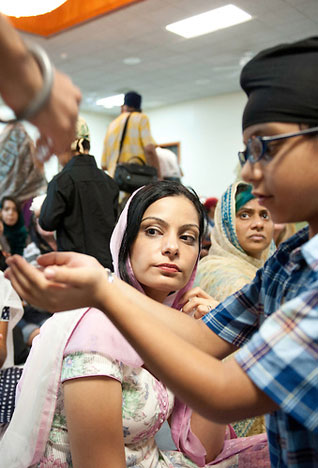Roundtable
Soul Food:
The Roundtable Open Forum # 150
CHITRA SWAMINATHAN
Parshad as a sacrament is an integral part of the Sikh way of life: the preparation, the sharing and partaking, and its symbolism. It is, however, in sharp contrast to similar practices in other faiths in that it is never allowed to be reduced to a ritual. Instead, it’s very raison d’etre is to reject ritual, especially idol worship and the ritual feeding of idols and deities.
We present this piece of culinary travelogue on sikhchic.com as the author surveys such practices across the subcontinent, flitting from Sikh to Hindu and then to Muslim places of worship.
Even as most of my colleagues busily devoured the huge laddu I brought back from my visit to Tirupati recently, the young curator of one of our food pages sat quietly. She did eat a small piece, but the reason behind the silence of the giggliest member of the gang came to the fore when she finally announced, “Please, I want a story on these laddus.”
Everybody burst out laughing, agreeing that it is neither a good idea to eat nor mention food in her presence.
“How can you write on prasadam (of course, the laddus are known globally for their taste),” I wondered aloud, popping into my mouth the remaining bits of the laddu. But her suggestion also set me thinking about the many traditions across the country that offer flavoursome eatables.
Just the other day, my Sikh colleague, who, on her way to office, visited the gurdwara on Vaisakhi, got a earful from the rest of us for not bringing back some of the delicious ghee-soaked parshad served there.
I have been to places of worship belonging to a variety of faiths, unable to resist straying into their kitchens for the unbeatable puri-halwa combination. I have grown up on this delightful blend, particularly served to little girls invited for kanjak during Navaratri.
For me, one of the attractions of visiting the Siddhivinayak Temple, a landmark of Mumbai, is the sabudana vadi (a sago preparation) sold nearby. Though a little high-on-oil, it’s hard to find such perfectly made vadis elsewhere. ‘Lord Ganesha’ also reminds one of the mouth-watering karanjis (flour dumplings stuffed with fresh or dry coconut and sugar, and deep-fried) and modaks (sweet dumplings with a coconut and jaggery stuffing; fried) given out to the devout at pandals during Ganesh Chaturthi in Pune and Mumbai.
Talking of food served at pandals, I have been to Durga and Kali pujas in Nagpur, just for the simple and comforting moong dal khichuri bhog (rice, pulses and vegetables cooked to a creamy consistency) served along with baingan bhaja (fried brinjal) and payash (kheer).
One of my friends in Chennai often makes weekend plans to visit the Parthasarathy Temple in Triplicane, just to savour the puliyodarai.
“There’s something unique about the taste that even my mother, who is an expert at making it, cannot match,” she would exclaim.
To verify her statement, I recently went to the temple, specially to meet the man who makes the puliyodarai.
“Though dry red chilli is one of the main ingredients in this traditional dish, we use pepper instead,” revealed Ramanujam, who is also an expert in making sakkarai pongal (made with pure ghee), another popular prasadam of the temple.
Talking of jaggery and ghee, this incredible combination that goes into the making of the aravana payasam makes me anxiously await a relative’s return from his annual Sabarimala pilgrimage. Offered to Ayyappa, it is rich in flavour and consists of rice, tiny bits of coconut, cardamom and cashew nut.
Your ascent up hills that are said to be spiritual abodes is usually rewarding. I have experienced it in Palani with that lip-smacking panchamirtham. Call it a traditional fruit mix, as it is prepared with crushed plantain (the small viruppachchi variety), kandasari sugar (from Kangeyam region), dates, raisins, kalkandu (sugar candy), cardamom and ghee in proper proportions.
For those who do not have a sweet tooth, there is always the milagu vadai distributed at most Anjaneyar Temples. Says my cousin, who’s a great vada-bhakt, “It’s different from the kind we make at home. The usual urad dal vadas are quite yummy at Kapaleeshwarar kovil. But the ones at Hanuman temples are made by grinding the dal to a very thick batter with barely any water; they are then flattened into small discs and deep-fried.”
And he adds in a lighter vein, “But those with dentures dare not bite into them.”
This culinary journey, with a hint of mysticism, has taken me all over the South and to some parts of the North, East and West. I remember how my friend, after a visit to Rajasthan, couldn’t stop talking about the qawwalis and kheer (tabarruk) distributed during Urs at Ajmer Sharif. Prepared in two huge cauldrons (deg), in the precincts of the dargah, it is garnished with dry fruits.
Coming back to laddus from where this story began, they are so popular that legal intervention had to be sought by the temple authorities to restrain small and big sweet outlets from selling laddus using the name ‘Tirupati’.
These patented laddus are a combination of besan, ghee, sugar, sugar candy, cardamom, raisin and cashew nut. More than two hundred thousand laddus are prepared every day in a kitchen that employs several hundred cooks. The tradition of the laddu itself is nearly 300 years old.
With a bag containing huge laddus in one hand and hot brimming-with-ghee sweet pongal in another, I began my descent from the hills and headed to the Padmavathi Temple in Tiruchanur, a visit to which is what people usually round off their Tirupati trip with.
And I ended it on a delicious note, treated to soft curd rice tempered with mustard seeds.
What else could make a Madrasi happy?
THE ROUNDTABLE OPEN FORUM # 150
Please share with us your experiences with parshad and langar you may have encountered in gurdwaras in different parts of Punjab, the subcontinent, and the world. Any surprises? Any unconventional practices, straying from the standard, traditional, simple, Punjabi fare?
[Courtesy: The Hindu newspaper. Edited for sikhchic.com]
April 24, 2015
Conversation about this article
1: Sangat Singh (Kuala Lumpur, Malaysia), April 24, 2015, 5:38 PM.
It was Guru Arjan who made the food for the palate into soul food and immortalized it in shabad: "Har dhan sanchan har nam bhojan ih Nanak kino cholha" [GGS:672.19] - "God is our wealth, His Name is our food; this, 0 Nanak, is our raiment." There is a Gurdwara Chola Sahib to commemorate Guru Arjan's visit to a village called Bhaini when a housewife served him Churi (a delicious concoction of broken roti pieces mixed with sugar and butter.) Guru Arjan blessed her and uttered a hymn of thanksgiving. There is also a Gurdwars Chola Sahib in the district of Tarn Taran.





